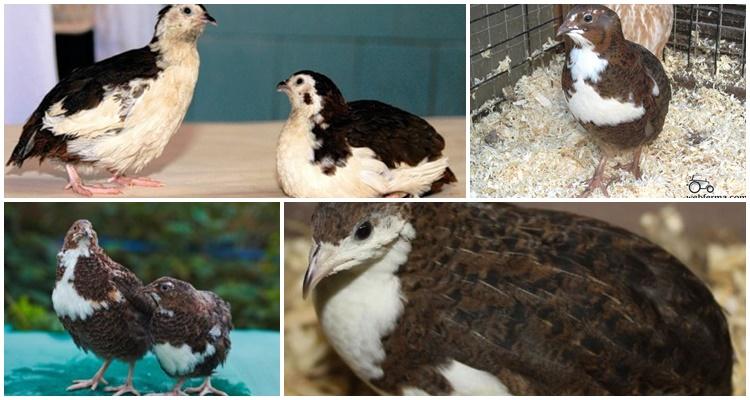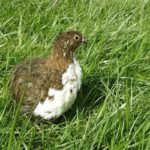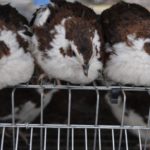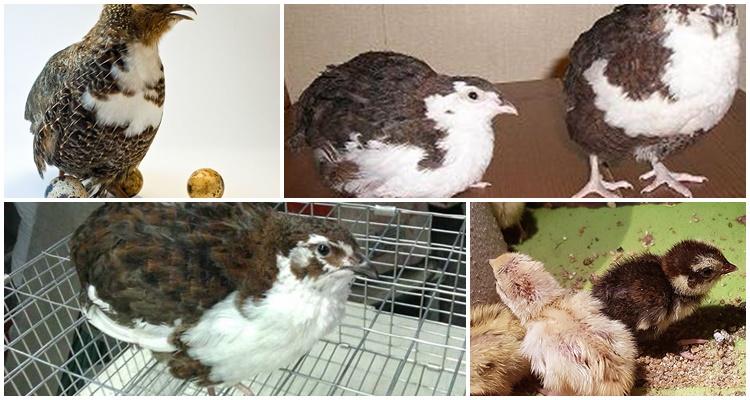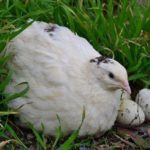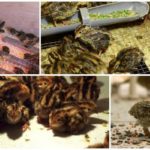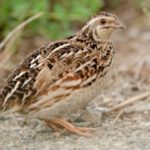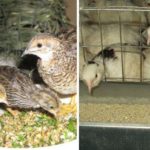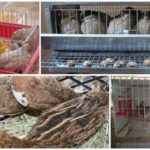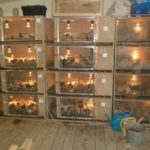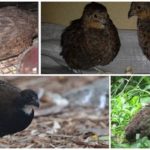Quails kept at home belong to different breeds. One of the varieties that is used for growing in private farms is tuxedo quail. Let's consider the description, characteristics, and productivity of the breed. How to keep birds at home, feed and breed them correctly. How to treat and prevent common diseases.
Description of the breed: productivity, advantages and disadvantages
The breed of tuxedo quail is a meat-egg type. The weight of an adult female is on average 160 g, males - 150 g. Oviposition begins at 1.5 months of age.During the season, each female demolishes 280 pieces. eggs weighing 10 g. Quail eggs are superior in quality to chicken eggs, and the meat is a delicacy. Eggs can be stored in the refrigerator for a long time, up to 2 months.
The plumage color of tuxedo quails is characteristic - dark back and head, white neck and chest. Because of the combination of colors, the breed got its name.
If we compare the pros and cons of the quail breed, it is obvious that the advantages prevail.
Conditions of detention and care
Tuxedo quail, like other breeds of quail, are kept in cages. They can be placed in a utility room, so there is no need to build a special building for them. But where the cells are located, it is necessary to maintain mandatory conditions - constant temperature and humidity. It should be warm all year round; if the birds are cold, they will stop laying eggs, and the weight gain of the young will also decrease. The humidity in the room should be about 70%.
It is better to buy tuxedo quails for the first time when they are 1.5 months old. These are young animals that will soon begin to lay eggs; they tolerate transportation well and adapt quickly.
Quails live in a mesh cage. For 1 bird you need 20 sq. see spaces.The floor of the cage can also be mesh; the droppings spill down into the tray, from where it is convenient to remove it. If there is no pallet, the floor is covered with paper, which is changed every day.
The cage should contain a feeder, a drinker, and a container with sand in which the birds will clean their feathers.
Diet planning
Tuxedo quails are raised to produce egg products, so nutrition must be complete, the diet is rich in nutrients, minerals and vitamins. One bird eats, on average, 25 g of food per day. You can feed them with mixed feed or mash of grain, root vegetables, vegetables with the addition of chalk, salt, and meat and bone meal. Chopped grass, garden herbs, green onions, and dairy waste are added to the mash. Feed tuxedo quails 2-3 times a day; those that are fattened – up to 4 times.
After hatching, the quail are fed a mixture of boiled eggs, herbs, and cottage cheese. Week-old chicks can be fed grated root vegetables, vegetables, and chopped grain. Month-old quails are transferred to the diet of adult birds.
Feeding quails with compound feed can be started from an early age and fed until slaughter. Birds should always have clean, fresh water. The frequency of feeding small quails is 5 times a day. Quails are fattened for meat until 3-3.5 months, after this age they are ready for slaughter. Next, the quails selected for breeding are fattened.
Subtleties of breeding
Breeding quails comprise families of 1 male and 4 females. While the quails lay eggs for incubation, the families are kept separate from the rest. They have enough cages with dimensions of 30 cm in height, length and width.
Tuxedo quails rarely incubate eggs, so the chicks are hatched in an incubator.The material is collected for 1-2 weeks and stored in a cool place until storage. Incubation lasts 16-17 days. After hatching, the quail are raised in a brooder. Young quails need to be provided with warmth and lighting, both of which can be provided by using an infrared lamp. It is hung above the brooder, maintaining a temperature of 35-38˚C during the first 1.5 weeks of the quail’s life. Then it is reduced, and by the age of one month it is brought to 22 ˚C.
Frequent illnesses
Tuxedo quail can suffer from contagious and non-contagious diseases. Infections can affect both young and adult livestock. The causes of infections are keeping birds in improper conditions, on contaminated wet bedding, and not carrying out disinfection measures. Infections spread quickly, and if there is a mass infection, the entire livestock can be lost.
Non-communicable diseases develop due to improper feeding and an incorrectly formulated diet. These are metabolic disorders and hypovitaminosis, pecking. Prevention measures include feeding foods that can provide quails with all the necessary substances.
When kept in the same cage, tuxedo quails can suffer from helminthic diseases. Therefore, they need to be treated periodically with antiparasitic drugs. Treat against external parasites - lice, feather eaters and fleas. For prevention, keep sand or ash in the cages.
Tuxedo quail are raised for their meat and eggs. But also as an ornamental bird due to its original coloring. The productive characteristics of the breed make it promising for home cultivation. Birds can be bred for your own needs, as well as for profit if you organize a quail farm.

